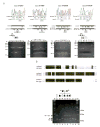Identification of a gene, ABCG5, important in the regulation of dietary cholesterol absorption
- PMID: 11138003
- PMCID: PMC1350991
- DOI: 10.1038/83799
Identification of a gene, ABCG5, important in the regulation of dietary cholesterol absorption
Abstract
The molecular mechanisms regulating the amount of dietary cholesterol retained in the body, as well as the body's ability to exclude selectively other dietary sterols, are poorly understood. An average western diet will contain about 250-500 mg of dietary cholesterol and about 200-400 mg of non-cholesterol sterols. About 50-60% of the dietary cholesterol is absorbed and retained by the normal human body, but less than 1% of the non-cholesterol sterols are retained. Thus, there exists a subtle mechanism that allows the body to distinguish between cholesterol and non-cholesterol sterols. In sitosterolemia, a rare autosomal recessive disorder, affected individuals hyperabsorb not only cholesterol but also all other sterols, including plant and shellfish sterols from the intestine. The major plant sterol species is sitosterol; hence the name of the disorder. Consequently, patients with this disease have very high levels of plant sterols in the plasma and develop tendon and tuberous xanthomas, accelerated atherosclerosis, and premature coronary artery disease. We previously mapped the STSL locus to human chromosome 2p21 and further localized it to a region of less than 2 cM bounded by markers D2S2294 and D2S2291 (M.-H.L. et al., manuscript submitted). We now report that a new member of the ABC transporter family, ABCG5, is mutant in nine unrelated sitosterolemia patients.
Figures





Similar articles
-
Genetic basis of sitosterolemia.Curr Opin Lipidol. 2001 Apr;12(2):141-9. doi: 10.1097/00041433-200104000-00007. Curr Opin Lipidol. 2001. PMID: 11264985 Free PMC article. Review.
-
Two genes that map to the STSL locus cause sitosterolemia: genomic structure and spectrum of mutations involving sterolin-1 and sterolin-2, encoded by ABCG5 and ABCG8, respectively.Am J Hum Genet. 2001 Aug;69(2):278-90. doi: 10.1086/321294. Epub 2001 Jul 9. Am J Hum Genet. 2001. PMID: 11452359 Free PMC article.
-
Accumulation of dietary cholesterol in sitosterolemia caused by mutations in adjacent ABC transporters.Science. 2000 Dec 1;290(5497):1771-5. doi: 10.1126/science.290.5497.1771. Science. 2000. PMID: 11099417
-
Biochemistry. An absorbing study of cholesterol.Science. 2000 Dec 1;290(5497):1709-11. doi: 10.1126/science.290.5497.1709. Science. 2000. PMID: 11186392
-
Sitosterolaemia: pathophysiology, clinical presentation and laboratory diagnosis.J Clin Pathol. 2008 May;61(5):588-94. doi: 10.1136/jcp.2007.049775. J Clin Pathol. 2008. PMID: 18441155 Review.
Cited by
-
Relationship of triglyceride-glucose index to gallstone prevalence and age at first gallstone surgery in American adults.Sci Rep. 2024 Jul 20;14(1):16749. doi: 10.1038/s41598-024-67883-0. Sci Rep. 2024. PMID: 39033195 Free PMC article.
-
Investigation of KIT gene mutations in women with 46,XX spontaneous premature ovarian failure.BMC Womens Health. 2002 Aug 2;2(1):8. doi: 10.1186/1472-6874-2-8. BMC Womens Health. 2002. PMID: 12153702 Free PMC article.
-
Monogenic dyslipidemias: window on determinants of plasma lipoprotein metabolism.Am J Hum Genet. 2001 Dec;69(6):1161-77. doi: 10.1086/324647. Epub 2001 Oct 26. Am J Hum Genet. 2001. PMID: 11704922 Free PMC article. Review. No abstract available.
-
Sterol Metabolism and Transport in Atherosclerosis and Cancer.Front Endocrinol (Lausanne). 2018 Sep 19;9:509. doi: 10.3389/fendo.2018.00509. eCollection 2018. Front Endocrinol (Lausanne). 2018. PMID: 30283400 Free PMC article. Review.
-
Dietary sitostanol and campestanol: accumulation in the blood of humans with sitosterolemia and xanthomatosis and in rat tissues.Lipids. 2005 Sep;40(9):919-23. doi: 10.1007/s11745-005-1452-7. Lipids. 2005. PMID: 16331855
References
-
- Bjorkhem, I. & Boberg, K.M. Inborn errors in bile acid biosynthesis and storage of sterols other than cholesterol. in The Metabolic Basis of Inherited Disease (eds. Scriver, C.R., Beaudet, A.L., Sly, W.S. & Valle, D.) 2073–2102 (McGraw-Hill, New York, 1995).
-
- Shulenin, S. et al. A liver-specific ATP-binding cassette gene (ABCG5) from the ABCG (White) gene subfamily maps to human chromosome 2p21 in the region of the sitosterolemia locus. Cyto. Cell Genet. (in press). - PubMed
Publication types
MeSH terms
Substances
Associated data
- Actions
- Actions
- Actions
Grants and funding
LinkOut - more resources
Full Text Sources
Other Literature Sources
Medical
Molecular Biology Databases

